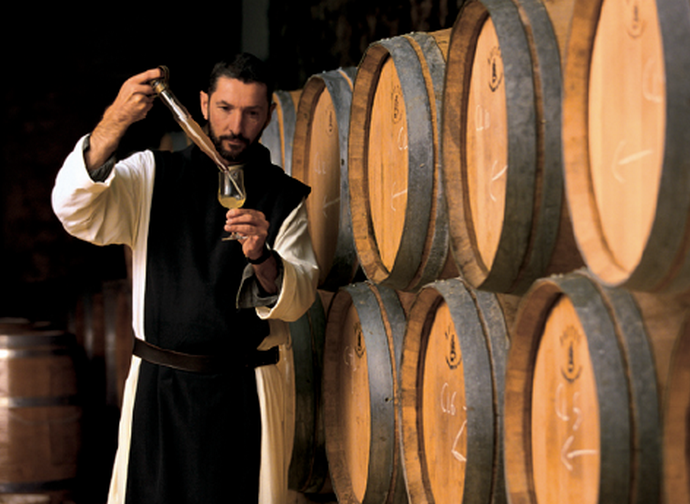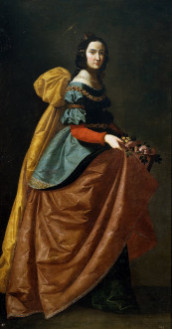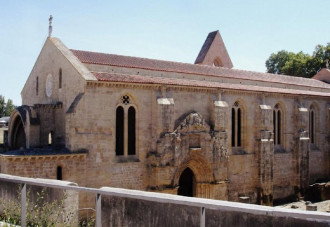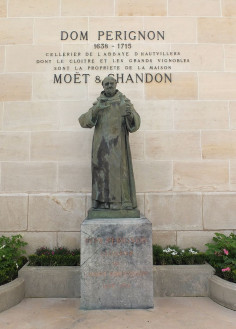The “science of wine” has a patron saint in Portugal
Saint Elizabeth, Queen of Portugal, is the only patron saint of oenologists and her personal history is intertwined with wine. Living at the turn of the 13th and 14th centuries, she called upon Don Edoardo de Aviz, a famous oenologist of the time, to help the nuns of the convent she had founded to produce a good wine, destined to be used for Mass in all the churches of Portugal.
- THE RECIPE: FISH AND SEAFOOD STEW

It is a late October morning in 1323 in Alvalade, a hamlet of Lisbon. Two armies, facing each other, are ready for battle. The stark silence is broken only by the cries of birds circling in the warm air. A light breeze carries the scent of citrus trees, which permeates the air.
A dark carriage with the royal arms painted in gold on the box stops not far away. The coachman helps a frail woman, dressed in black, to disembark. She passes through the space separating the two armies, her black dress billowing in the breeze and a large golden cross hanging from her neck, which she holds in her hand as if to absorb its strength. A ray of light accompanies her and stretches out, becoming a luminous barrier separating the two armies. She does not say a word, just looks ahead and continues walking. As she passes, the light becomes more intense. The men get down on their knees, on either side and lower their heads.
 She is Elisabeth, the Queen of Portugal.
She is Elisabeth, the Queen of Portugal.
The two armies were brought together by two men, father and son, King Dionysius of Portugal and Crown Prince Alfonso (later to become King Alfonso IV). Both are dear to her heart, one is her husband, the other her son, and the idea of seeing them tear each other apart terrifies her.
She prayed all night in her private chapel, remaining in adoration, and the Lord showed her the way. She reflected that those soldiers were also someone’s sons, someone’s husbands. And she decided to go and see them, asking the Holy Spirit for light. And she was answered. The two armies withdrew, the bloodshed was avoided.
This is an episode from the life of the future Saint Elizabeth of Portugal (1271 - 1336), mentioned in a manuscript preserved in the Parra Collection. But this gesture cost her her freedom, because her husband accused her of siding with their son and banished her from Court, confining her to a fortress. She came out again when the king died; she donated her crown to the Sanctuary of Compostela, where she made a pilgrimage. She then donated all her possessions to the poor and to convents and became a Franciscan of the third order, retiring to the monastery of the Poor Clares of Coimbra (where she would end her earthly existence).
She was a woman who dedicated her life to her family, her country, and God. She was nicknamed “the peacemaker”, because she had the ability to de-escalate conflicts and restore peace (as in the episode described above).
She was canonised in 1625, under Pope Urban VIII, and her feast day is celebrated on the 4th of July. She is the only patron saint of oenologists (almost all professions have more than one patron, but oenologists only have her).
 St Elizabeth of Portugal and wine have intertwined histories. It all began even before she took her vows, in the very monastery of the Poor Clares of Coimbra (which she had built while she was queen, pictured right). The monastery was located in the middle of a large expanse of vineyards. Here the queen decided to produce wine for the Masses of all the churches in Portugal.
St Elizabeth of Portugal and wine have intertwined histories. It all began even before she took her vows, in the very monastery of the Poor Clares of Coimbra (which she had built while she was queen, pictured right). The monastery was located in the middle of a large expanse of vineyards. Here the queen decided to produce wine for the Masses of all the churches in Portugal.
The Poor Clare nuns worked the land and the vines, but to make good wine the queen sent Don Edoardo de Aviz, a great wine merchant and an unparalleled expert in the “chemistry” of wine. It was he who “composed” the wine of the Poor Clares, combining different grape varieties, supervising the large barrels in which the wine matured and controlling its transport to the most remote Portuguese districts and their churches.
Don Edoardo was an oenologist. He was a navigator and wine merchant at a time when Portugal dominated this trade. They had achieved success selling wine to England, Flanders, and the cities of the Hanseatic League, wresting the “sceptre” of this trade from Castile and Aragon.
Portugal had conquered the market and was now defending its commercial independence with force of arms. The long struggle to drive out the Moors with the help of foreign crusaders and the Knights Templar gave a religious seal to the desire for conquest. In no other people was the ancient spirit of the Crusades so deeply embedded. To wage war against Islam then appeared to the Portuguese as their natural destiny and duty as Christians.
In this context, wine became a symbol, and the need to maintain its high quality forged the professional figure of the oenologist, which began where that of the vine-grower ended. Oenology is a complex science and the oenologist is a professional figure who follows all the phases of wine production: from the production of the grapes, to the definition of the processing protocol, to the evaluation of the quality of the grapes, to the bottling and marketing of the finished product.
It is actually an ancient profession, which began long before the time of Elisabeth. If we look at the documents that talk about the science of making wine, we find as early as the 3rd century B.C. the writings of Mago the Carthaginian, author of a 28-volume treatise on agronomy in the Phoenician language, which was to be one of the most important sources on the subject throughout the classical period. The original text has been lost, but fragments of Greek and Latin translations have survived. In 146 B.C., the Third Punic War ended with the destruction of Carthage by the Romans. The contents of the Punic libraries were handed over to the Numidian rulers – Rome’s allies – with the exception of Mago’s work, which was taken to Rome where it was translated into Latin by Decimus Silanus. The work - already popular because of the Greek translation by Cassius Dionysius, a contemporary of Mago - was later readapted by Diophanes of Nicaea, who divided it into six volumes.
The first treatise on viticulture was written by Theophrastus (371-287 B.C.). In his work “Research on Plants”, he analyses the physiology of the vine, pruning methods and the diseases that attack it. He describes the methods of the Greek vine-growers, who did not support the vines with a pergola, as the Egyptians did and as the Italians did later. Instead, they left the vines low, resting on the ground, except for the necessary supports to protect them from humidity. Theophrastus was a disciple of Aristotle, who succeeded him as director of the Lyceum (the Peripatos) in 322 B.C.
He was followed by Marcus Porcius Cato (234-149 B.C.), whose work “De agricoltura” of 160 B.C. is the first complete prose work that has come down to us in the Latin language and gives an idea of the importance of viticulture in the Italic agricultural economy around the 2nd century B.C.. Then came Marcus Terentius Varro (116-27 B.C.), who in “De re rustica” gives a “snapshot” of the oenology of his time; Strabo (58 B.C.-21 A.D.), author of the “Geographia”, in which we find the most complete account of the distribution of viticulture and wines in the “known world” at the end of the Republic and the beginning of the Empire (Mediterranean countries).
In our era, we must mention Columella (4-70 A.D.), author of the magnificent work “De Re Rustica” and the greatest agricultural scholar in Imperial Rome.
Pliny the Elder, who lived between the two eras, wrote an unparalleled work, ranging from agricultural to historical, from scientific to folkloric aspects, entitled “Naturalis Historia”: a great encyclopaedia in 37 books, still of great help today in understanding life in the Latin age and especially wine production at the time.
Rotari (606 - 652) was king of the Lombards and king of Italy from 636 to 652. The Longobards radically transformed the Roman land structure and a new agricultural aristocracy was created: they had great respect for wine, a symbol of nobility and, as northern peoples, were very attracted to the Italian pretiosa vina. In order to restore strength to agriculture and in particular to viticulture, which had been weakened by centuries of neglect and raids, in 643 Rotari issued the “Edict of Rotari” (643), which contains articles concerning the protection of the vine that document the importance attached to viticulture even in those times.
Charlemagne (742 - 814) also issued the “Capitulare de Villis et Curtis Imperatoris” in 789, a collection of rules and regulations in which many chapters are a compilation of agricultural rules and techniques devoted to viticulture, wine and its taxation. The document was implemented by the “Missi dominici” (the sovereign’s inspectors) who had to impose it on imperial estates. Charlemagne and the Franks had a genuine veneration for wine and its quality: some articles of the “Capitulare” impose the utmost care in the cleaning of wine vases and the preparation of wine, and demand that presses should never be lacking in rural businesses.
In the Italian Middle Ages, Pier de’ Crescenzi (1233 - 1320) was a writer and agronomist from Bologna. He is considered the greatest agronomist of the Western Middle Ages (but he is also a scholar of philosophy, medicine, natural sciences, and law). In his work “Liber commodorum ruralium”, completed between 1304 and 1309, he provides much information on the ways in which the traditions of classical viticulture were interpreted in Italy during the Middle Ages.
In the 16th century we find another great oenologist: Sante Lacerio (1500 - 1565), “Papal Bottler” as he liked to call himself. He looked after the wines of His Holiness Paul III, who, frail in appearance but strong by nature, lived and governed the Church until the ripe old age of 82. He was helped in his search for the best wines by his trusted advisor Lancerio, proof that good drinking helps to prolong life in serenity and wisdom. As well as being an oenologist, Lancerio can also be considered the first sommelier ever to be responsible for His Holiness’ wine supplies, both at home and when travelling. Lacerio followed his task with skill and passion, tasting, sipping, observing, and advising on the various types of drink. He is the author of an extraordinary document, “Letter on the quality of wines”, the details of which are mentioned here.
Also in the 16th century, considered to be “the century of abundant imbibing”, we find Castore Durante da Gualdo (1529 - 1590), an Italian Renaissance physician, botanist and poet, who published important works, such as “Herbario nuovo” and the “Tesoro della sanità”, in which he writes about wine: “Moderately consumed, wine gives birth to many comforts for the spirit and the body, so that the spirit becomes more faithful and docile, the soul expands, the spirits are comforted, the joys multiply, the sorrows are forgotten; it clarifies the intellect, excites the mind, cools down anger, relieves melancholy, induces elation...”.
 In the 17th century, we mention Dom Pérignon, oenologist par excellence, author of the first champagne “cave”, which he created for Louis XIV (the Sun King). He was a religious man, “cellarer” in the Abbey of Hautvillers, universally recognised as the creator of champagne: blending of grapes and wines, rapid and fractioned pressing of the black grapes to extract a white and crystalline juice, use of the first thick and resistant glass bottles; replacement of a wooden stopper covered with hemp by a cork from Spain, held in place by a cord to preserve the fizz; ageing in cellars dug into tuff, capable of ensuring a constant temperature and limiting alterations.
In the 17th century, we mention Dom Pérignon, oenologist par excellence, author of the first champagne “cave”, which he created for Louis XIV (the Sun King). He was a religious man, “cellarer” in the Abbey of Hautvillers, universally recognised as the creator of champagne: blending of grapes and wines, rapid and fractioned pressing of the black grapes to extract a white and crystalline juice, use of the first thick and resistant glass bottles; replacement of a wooden stopper covered with hemp by a cork from Spain, held in place by a cord to preserve the fizz; ageing in cellars dug into tuff, capable of ensuring a constant temperature and limiting alterations.
And we could continue to the present day, but we will stop here, for lack of space. The fact is that the figure of a woman of faith and noble queen will remain indissolubly linked for eternity to an equally noble professional figure, that of the oenologist.




